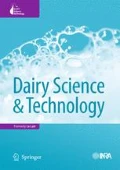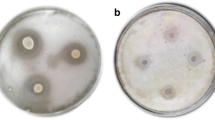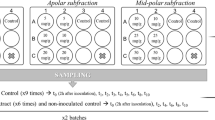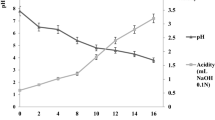Abstract
The aim of this study was to evaluate the antibacterial and antifungal activities of water-soluble extracts (WSEs) from different types of cheeses against several food-borne pathogens. A total of five commercial cheeses manufactured in Canada were selected namely Mozzarella, Gouda, Swiss, and old and medium Cheddar. WSEs were ultrafiltrated through 10 kDa cutoff membranes and desalted using Sep-Pak cleanup column. Resulting peptide fractions were subject to physicochemical characterization and assessment for their antimicrobial activity against bacteria (Listeria ivanovii, Listeria monocytogenes, Escherichia coli MC4100, and E. coli O157:H7) and filamentous fungi (Aspergillus, Mucor, Fusarium, and Penicillium). Mozzarella and Gouda WSEs were the most active and inhibited with L. monocytogenes significantly, with respective reductions of 3.83 ± 0.15 and 2.93 ± 0.33 log. After desalting and organic acids removal, Mozzarella and Gouda WSEs produced 3-log reductions of L. ivanovii and E. coli MC4100, with minimal inhibitory concentration (MIC) values ranging 8.5–17 mg.mL−1. At a concentration of 34 mg.mL−1, all cheese peptidic WSEs induced a delay in spore germination. All WSEs were equally active against Fusarium sp., with a minimal concentration of 17 mg.mL−1. Gouda, Mozzarella, and medium Cheddar WSE were the strongest inhibitors in the case of Aspergillus versicolor and Mucor racemosus (17 mg.mL−1), whereas these spores were less sensitive to old Cheddar and Swiss WSE (34 mg.mL−1). This study demonstrates that peptidic WSEs of commercial cheeses manufactured in Canada exhibit antibacterial and antifungal activities, which may offer a promising alternative for purposes of food preservation.

Similar content being viewed by others
References
Almaas H, Eriksen E, Sekse C, Comi I, Flengsrud R, Holm H, Jensen E, Jacobsen M, Langsrud T, Vegarud GE (2011) Antibacterial peptides derived from caprine whey proteins, by digestion with human gastrointestinal juice. Br J Nutr 106(6):896–905. doi:10.1017/s0007114511001085
Ayad EHE, Verheul A, Wouters JTM, Smit G (2001) Population dynamics of lactococci from industrial, artisanal and non-dairy origins in defined strain starters for Gouda-type cheese. International Dairy Journal 11 (1–2):51–61. doi:10.1016/S0958-6946(01)00041-3.
Bellamy W, Yamauchi K, Wakabayashi H, Takase M, Takakura N, Shimamura S, Tomita M (1994) Antifungal properties of lactoferricin B, a peptide derived from the N-terminal region of bovine lactoferrin. Lett Appl Microbiol 18(4):230–233. doi:10.1111/j.1472-765X.1994.tb00854.x
Bissonnette F, Labrie S, Deveau H, Lamoureux M, Moineau S (2000) Characterization of Mesophilic Mixed Starter Cultures Used for the Manufacture of Aged Cheddar Cheese. J Dairy Sci 83 (4):620–627. doi:10.3168/jds.S0022-0302(00)74921-6.
Bligh EG, Dyer WJ (1959) A rapid method of total lipid extraction and purification. Can J Physiol Pharmacol 37(8):911–917
Demers-Mathieu V, Gauthier SF, Britten M, Fliss I, Robitaille G, Jean J (2013) Antibacterial activity of peptides extracted from tryptic hydrolyzate of whey protein by nanofiltration. Int Dairy J 28(2):94–101. doi:10.1016/j.idairyj.2012.09.003
Dubois M, Gilles KA, Hamilton JK, Rebers PA, Smith F (1956) Colorimetric method for determination of sugars and related substances. Anal Chem 28(3):350–356. doi:10.1021/ac60111a017
El-Salam MHA, El-Shibiny S (2012) Bioactive peptides of buffalo, camel, goat, sheep, mare, and yak milks and milk products. Food Rev Int 29(1):1–23. doi:10.1080/87559129.2012.692137
Exterkate FA, Alting AC (1995) The role of starter peptidases in the initial proteolytic events leading to amino acids in Gouda cheese. International Dairy Journal 5 (1):15–28. doi:10.1016/0958-6946(94)P1596-6.
Fox PF, McSweeney PLH (2004) Cheese: an overview. In: Cheese: chemistry, physics and microbiology, vol 1. New York: Academic Press, pp 1–18
Hammami R, Zouhir A, Hamida JB, Neffati M, Vergoten G, Naghmouchi K, Fliss I (2009) Antimicrobial properties of aqueous extracts from three medicinal plants growing wild in arid regions of Tunisia. Pharm Biol 47(5):452––457. doi:10.1080/13880200902822604
Hayes M, Ross RP, Fitzgerald GF, Hill C, Stanton C (2006) Casein-derived antimicrobial peptides generated by Lactobacillus acidophilus DPC6026. Appl Environ Microbiol 72(3):2260–2264. doi:10.1128/aem.72.3.2260-2264.2006
Hernández-Ledesma B, Ramos M, Gómez-Ruiz JÁ (2011) Bioactive components of ovine and caprine cheese whey. Small Rumin Res 101(1–3):196–204. doi:10.1016/j.smallrumres.2011.09.040
Jardin J, Mollé D, Piot M, Lortal S, Gagnaire V (2012) Quantitative proteomic analysis of bacterial enzymes released in cheese during ripening. Int J Food Microbiol 155(1–2):19–28. doi:10.1016/j.ijfoodmicro.2012.01.008
Jenkins JK, Harper WJ, Courtney PD (2002) Genetic diversity in Swiss cheese starter cultures assessed by pulsed field gel electrophoresis and arbitrarily primed PCR. Letters in Applied Microbiology 35 (5):423–427. doi:10.1046/j.1472-765X.2002.01212.x.
Kindstedt PS, Fox PF (1993) Effect of manufacturing factors, composition, and proteolysis on the functional characteristics of mozzarella cheese. Critical Reviews in Food Science and Nutrition 33 (2):167–187.
Kuchroo CN, Fox PF (1982) Soluble nitrogen in Cheddar cheese: comparison of extraction procedures. Milchwissenschaft 37:331–335
Lahov E, Regelson W (1996) Antibacterial and immunostimulating casein-derived substances from milk: casecidin, isracidin peptides. Food Chem Toxicol 34(1):131–145. doi:10.1016/0278-6915(95)00097-6
Lignitto L, Segato S, Balzan S, Cavatorta V, Oulahal N, Sforza S, Degraeve P, Galaverna G, Novelli E (2012) Preliminary investigation on the presence of peptides inhibiting the growth of Listeria innocua and Listeria monocytogenes in Asiago d’Allevo cheese. Dairy Sci Technol 92(3):297–308. doi:10.1007/s13594-012-0057-6
Losito I, Carbonara T, De Bari MD, Gobbetti M, Palmisano F, Rizzello CG, Zambonin PG (2006) Identification of peptides in antimicrobial fractions of cheese extracts by electrospray ionization ion trap mass spectrometry coupled to a two-dimensional liquid chromatographic separation. Rapid Commun Mass Spectrom 20(3):447–455. doi:10.1002/rcm.2323
Meira SMM, Daroit DJ, Helfer VE, Corrêa APF, Segalin J, Carro S, Brandelli A (2012) Bioactive peptides in water-soluble extracts of ovine cheeses from Southern Brazil and Uruguay. Food Res Int 48(1):322–329. doi:10.1016/j.foodres.2012.05.009
Möller N, Scholz-Ahrens K, Roos N, Schrezenmeir J (2008) Bioactive peptides and proteins from foods: indication for health effects. Eur J Nutr 47(4):171–182. doi:10.1007/s00394-008-0710-2
Nguyen Thi P, Dupas C, Adt I, Degraeve P, Ragon M, Missaoui M-F, Novelli E, Segato S, Phan The D, Oulahal N (2014) Partial characterisation of peptides inhibiting Listeria growth in two Alpine cheeses. Dairy Sci Technol 94(1):61–72. doi:10.1007/s13594-013-0141-6
Pritchard SR, Phillips M, Kailasapathy K (2010) Identification of bioactive peptides in commercial Cheddar cheese. Food Res Int 43(5):1545–1548
Reinbold GW (1972) Swiss cheese varieties, vol 5. Pfizer cheese monographs. Pfizer, New York.
Rizzello CG, Losito I, Gobbetti M, Carbonara T, De Bari MD, Zambonin PG (2005) Antibacterial activities of peptides from the water-soluble extracts of Italian Cheese varieties. J Dairy Sci 88(7):2348–2360. doi:10.3168/jds.S0022-0302(05)72913-1
Salami M, Moosavi-Movahedi AA, Ehsani MR, Yousefi R, Haertlé T, Chobert J-M, Razavi SH, Henrich R, Balalaie S, Ebadi SA, Pourtakdoost S, Niasari-Naslaji A (2010) Improvement of the antimicrobial and antioxidant activities of camel and bovine whey proteins by limited proteolysis. J Agric Food Chem 58(6):3297–3302. doi:10.1021/jf9033283
Settanni L, Moschetti G (2010) Non-starter lactic acid bacteria used to improve cheese quality and provide health benefits. Food Microbiol 27(6):691–697. doi:10.1016/j.fm.2010.05.023
Sheehan A, O'Loughlin C, O'Cuinn G, FitzGerald RJ, Wilkinson MG (2005) Cheddar cheese cooking temperature induces differential lactococcal cell permeabilization and autolytic responses as detected by flow cytometry: implications for intracellular enzyme accessibility. Journal of Applied Microbiology 99 (5):1007–1018. doi:10.1111/j.1365-2672.2005.02718.x.
Théolier J, Fliss I, Jean J, Hammami R (2014a) Antimicrobial peptides of dairy proteins: from fundamental to applications. Food Rev Int. doi:10.1080/87559129.2014.896017
Théolier J, Fliss I, Jean J, Hammami R (2014b) MilkAMP: a comprehensive database of antimicrobial peptides of dairy origin. Dairy Sci Technol 94(2):181–193. doi:10.1007/s13594-013-0153-2
Théolier J, Hammami R, Labelle P, Fliss I, Jean J (2013) Isolation and identification of antimicrobial peptides derived by peptic cleavage of whey protein isolate. J Funct Foods 5(2):706–714. doi:10.1016/j.jff.2013.01.014
van der Kraan MIA, Nazmi K, Teeken A, Groenink J, van’t Hof W, Veerman ECI, Bolscher JGM, Nieuw Amerongen AV (2005) Lactoferrampin, an antimicrobial peptide of bovine lactoferrin, exerts its candidacidal activity by a cluster of positively charged residues at the C-terminus in combination with a helix-facilitating N-terminal part. Biol Chem 386:137–142
Wakabayashi H, Hiratani T, Uchida K, Yamaguchi H (1996) Antifungal spectrum and fungicidal mechanism of an N-terminal peptide of bovine lactoferrin. J Infect Chemother 1(3):185–189. doi:10.1007/bf02350646
Acknowledgments
This work is supported by the Fonds québécois de la recherche sur la nature et les technologies (FQRNT). JT was receipt of a Ph.D. fellowship from FQRNT.
Author information
Authors and Affiliations
Corresponding author
About this article
Cite this article
Théolier, J., Hammami, R., Fliss, I. et al. Antibacterial and antifungal activity of water-soluble extracts from Mozzarella, Gouda, Swiss, and Cheddar commercial cheeses produced in Canada. Dairy Sci. & Technol. 94, 427–438 (2014). https://doi.org/10.1007/s13594-014-0170-9
Received:
Revised:
Accepted:
Published:
Issue Date:
DOI: https://doi.org/10.1007/s13594-014-0170-9




